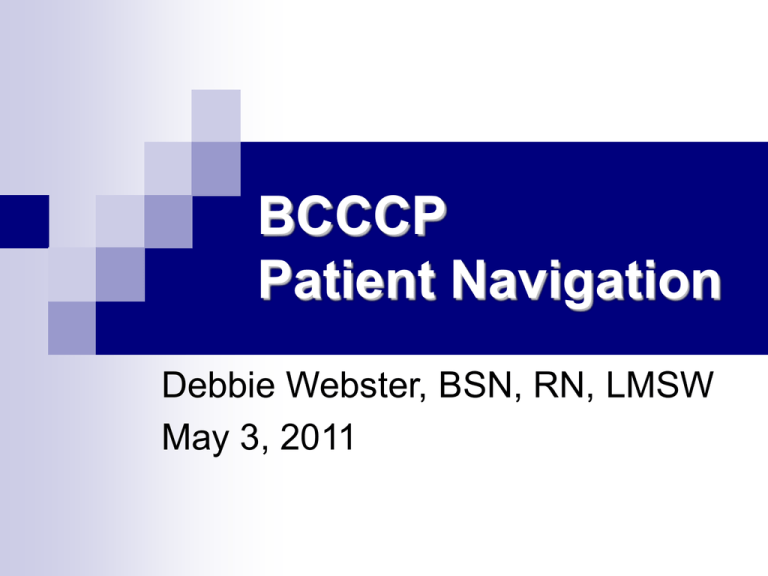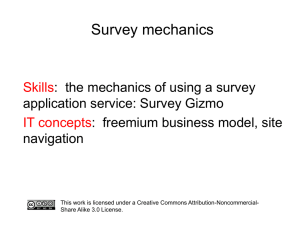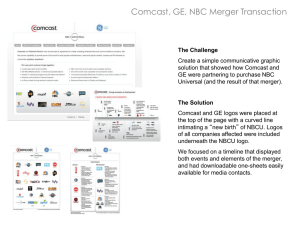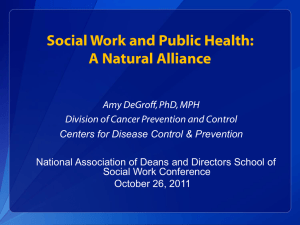Patient Navigation Presentation
advertisement

BCCCP Patient Navigation Debbie Webster, BSN, RN, LMSW May 3, 2011 Patient Navigation Defined Timely movement of an individual through the health care continuum from prevention, detection, diagnosis, treatment support and end of life care www.patientnavigation.com Individualized assistance offered to patients to help overcome barriers to care, whether through the health care system or the environment American College of Surgeons – Cancer Program Standards 2011 Harold P. Freeman “Disease always occurs within a context of human circumstances including economic status, social position, culture and environment. These human circumstances can determine the length and quality of survival. ” Navigation vs. Case Management One of Navigation’s primary purposes is to decrease cancer disparities. The focus on disparities is a major distinguishing factor between Patient Navigation and Case Management. Disparities in Cancer Care The 5-year survival rate after a 1st diagnosis of breast cancer is 90% for white women and 77% for African women. Racial/ethnic differences in: Stage at diagnosis (Robinson-White, et. al. 2010) Mammography utilization (Battaglia, et. al., 2007) Follow-up after abnormal breast screening Racial/ethnic minority women often have the longest delays (Battaglia, et. al., 2007) Early termination of treatment (Ell et. al., 2009) Barriers to Care Financial barriers (insurance) Communication barriers (language) Lack of information or misinformation Missed appointments (might be due to work, child care or transportation issues) Medical system (lost medical reports) Fear & emotional barriers Cancer Burden A patient without health insurance who has a diagnosis of cancer can expect a 15% lower 5-year survival than one who is insured. Survival rates for those on Medicaid are essentially the same. Navigation’s History 1st program – 1990 Harlem, NY Population predominantly African American and Hispanic Most residents live in poverty Most residents have a low educational level The Goal - Increase 5-year survival rates of cancer by helping patients move through the diagnostic and treatment Does Navigation Work? 1st program outcomes 1964-1986 the 5-year survival rate at Harlem Hospital = 39 % (60% for white women) 1995-2000 the 5-year survival rate at Harlem Hospital = 70% Stage 0 Stage I Stage II Stage III Stage IV 19641986 19952000 0% 12% 6% 29% 45% 38% 39% 14% 10% 7% Does Navigation Work? Additional Outcomes Earlier diagnosis Stage 0 diagnosis went from 12.4% to 25.8% Stage IV diagnosis went from 16.7% to 9.4% Gabram et. al. (2008) Diagnostic resolution 90% of navigated Hispanic women followed through to diagnostic resolution compared to 66% of non-navigated women Ell et.al. (2007) More Outcomes Battaglia et. al. (2006) reported that women were 39% more likely to have timely follow up on a diagnostic evaluation after implementation of Patient Navigation. Fang et. al. (2007) reported that the cervical cancer screening rate increased from 17% to 83% in Korean women after the introduction of cervical cancer education and bilingual patient navigation. Navigation in Cancer Care Research consistently shows Navigation to be effective at moving patients across the Cancer Care Continuum Identifying & bringing patients into screening Walking them through the steps of detection and diagnosis when necessary Facilitating complete and timely treatment An individualized needs assessment is key Key components of Patient Navigation: Removing barriers to care for individual patients Documenting these barriers Implementation of a feedback system regarding barriers aimed at system level change (requires administrative support) Vargas et. al. (2008) Cancer Continuum Prevention Detection Diagnosis Treatment Survivorship Prevention Navigation Primary prevention Targeted outreach HPV vaccinations Colorectal cancer screening & polyp removal Secondary Prevention Targeted outreach to identifying cancer at an earlier, more treatable stage Increasing the % of enrolled patients who are up to date on breast and cervical cancer screenings Navigation and Outreach CDC recommends the following: Client reminders Small media One-on-one education Reducing structural barriers The Community Guide www.thecommunityguide.org Outreach - Client reminders Effective with print or telephone communication. Can include things like: Reminding people they are due (or late) for screening. Information about screening Benefits of screening Ways to overcome barriers to screening The Community Guide It is important to have a feedback system in place to determine if the client followed-up on the reminder. Outreach – Small Media Videos & printed communications (letters, brochures, flyers, newsletters) Convey educational or motivational information Describe screening tests and procedures Provide reasons for and benefits of screening Suggest ways to overcome barriers to screening Can address a general population or tailored to a specific population The Community Guide Outreach – One-on-one Education Can be by telephone or face-to-face Nurse, health educator, lay health advisor, volunteer Education can be general or targeted to the specific circumstances of the individual The Community Guide Outreach – Reducing Structural Barriers Activities that make it easier for people to access preventive services: Modifying hours of service to meet client needs (evening and weekend hours) Offering services in alternative nonclinical settings (mobile vans) Transportation assistance Translation services The Community Guide Navigation and Detection Navigation increases the percentage of patients who complete their screening or diagnostic test Decreasing missed appointments Increasing the timeliness of screening completion Decreasing the number of patients who are lost to follow-up Navigation & Screening Education on importance of cancer screening Explaining cancer screening process Reminders of appointments Assistance in rescheduling if appointments are missed Emotional support – addressing fears Assistance with transportation, child care or other barriers to screening Navigation’s Impact on Screening Research shows that any type of navigation aimed at increasing screening has an impact Detrich (2006) tested telephone navigation and found that it impacted screening rates of mammography, pap tests and colorectal cancer screening Navigation and Diagnosis Patient Education Importance of diagnostic follow-up Explaining cancer diagnostic test process Patient Support Emotional support – addressing fears Reduce Barriers Appointment Reminders Navigation and Diagnosis Easy and timely access to surgical consultations post-abnormal finding is essential to a woman’s emotional wellbeing Increasing the timeliness (decreasing number of days) between abnormal screening result and diagnostic completion Navigate through health care setting A patient’s perspective "Sara feels like an angel sent to me. It’s unbelievable to have someone within the medical system come alongside you, anticipate your needs, hear your concerns, and offer help.“ ~ Breast cancer patient Steelquist, 2009 Care Coordination Problems A 2006 survey : Half of cancer patients say that care was uncoordinated at times. The sickest patients and those with the deadliest tumors were most likely to encounter a problem. Records or test results did not reach doctor in time for appointment - 13% Left a doctor's office with critical question unanswered 15% Confused about prescription medication - 20% Sent for duplicate tests - 21% Given conflicting information from doctors or nurses - 25% Any of these coordination problems - 50% Navigation and Treatment Continued assistance with navigating the health care setting Tracking patients diagnosed with cancer into the start of treatment Increasing timeliness (decreasing number of days) between diagnosis and initiation of cancer treatment Coordinating care among different providers Have medical records available at appointments Assist in scheduling of follow-up appointments and their reminders Navigation and Treatment Decrease disparities by improving access Ensure Build awareness of all available services Help unrestricted access to all services clarify choices Dispel fears so patient seeks appropriate care options Dispelling fear can increase compliance with treatment care recommendations Education on the treatment phase “Even more than the cancer fears, the financial worries were eating me alive. I knew treatment was going to be expensive and I didn’t want to burden my kids. But I wanted to live” ~ A breast cancer patient Steelquist, 2009 Navigation and Survivorship Transitional care Proactive management of health Long-term (Survivorship) Care Plan Maintain appropriate follow-up Symptom management Wellness/nutrition Emotional concerns Support groups Stress management Navigation and Survivorship Few models on this type of navigation No research has been done Many hospital Nurse Navigators add survivorship issues into their plan of care for patients Follow up calls on HRT therapy We can’t hire a Navigator Patient Navigation Team In many programs, the roles of the Navigator is divided among multiple staff Unmet needs are identified and then split based on the skills of each team member “Poverty should not be an offense punishable by death.” ~ Harold Freeman, MD cancerpatientnavigation.org Questions? Illustration: Guy Billout References American College of Surgeons Commission on Cancer. (2011) Working draft: Cancer program standards 2012: Ensuring patient-centered care. Retrieved on February 7, 2011 from http://www.facs.org/cancer/coc/cps2012draft.pdf Battaglia, T., Roloff, K., Posner, M., & Freund, K. (2007) Improving follow-up to abnormal breast cancer screening in an urban population. Cancer. 109(2); 359366. Center for Disease Control. (2010) Using evidence for public health decision making: Screening for breast, cervical and colorectal cancer. The Guide to Community Preventative Services. Dillon, T. (2006) Cancer care often uncoordinated. Retrieved on April 7, 2011 from http://www.usatoday.com/news/health/2006-11-19-cancer-care_x.htm Ell, K., Vourlekis, B., Xie, B., Nedjat-Halem, F., Lee, P., Muderspach, L., Russell, C., & Palinkas, L. (2009) Cancer treatment adherence among low-income women with breast or gynecologic cancer. Cancer. (October); 4606-4615. Ell, K., Vourlekis, B., Lee, P., & Xie, B. (2007) Patient navigation and case management following an abnormal mammogram: A randomized clinical trial. Preventative Medicine. (44); 26-33. References Fang, C., Ma, G., Tan, Y., & Chi, N. (2007) A multifaceted intervention to increase cervical cancer screening among underserved Korean women. Cancer Epidemilogy, Biomarkers & Prevention. 16(6); 1298-1302. Freeman, H. (2004) A model patient navigation program. Oncology Issues (September/October); 44-46. Freeman, H. (2008) Patient navigation: Community centered approach to reduce cancer mortality. Retrieved on January 20, 2011 from http://georgiacancer.org/treat/pat.nav.pdf Gabram, S., Lund, M., Hatchett, N., Bumpers, H., Okoli, J., Johnson, B., Kirkpatrick, G., Brawley, O. (2008) Effects of an outreach and internal navigation program on breast cancer diagnosis in an urban center with a large African-American population. Cancer. 113(3); 602-607. Pfizer. Cancer patient navigation overview. Retrieved on February 14, 2011 from http://www.cancerpatientnavigation.org Robinson-White, S., Conroy, B., Slavish, K., & Rosenzweig, M. (2010) Patient navigation in breast cancer: a systematic review. Cancer Nurse. 33(2); 127-140. Steelquist, C. (2009) On the right path. Retrieved on February 11, 2011 from http://www.fhcrcorg/about/pubs/quest/articles/2009/path.html.




